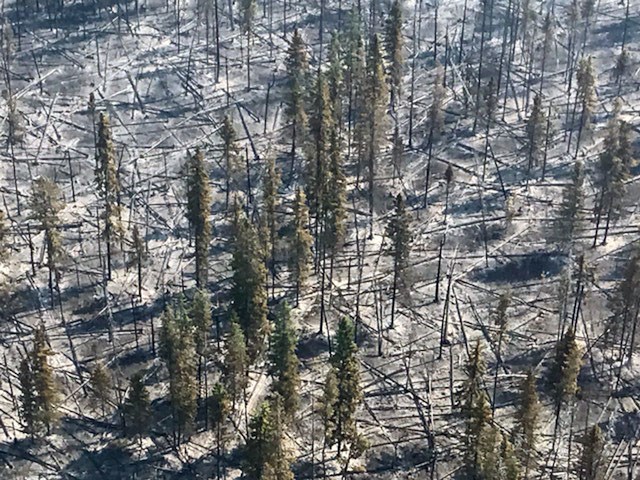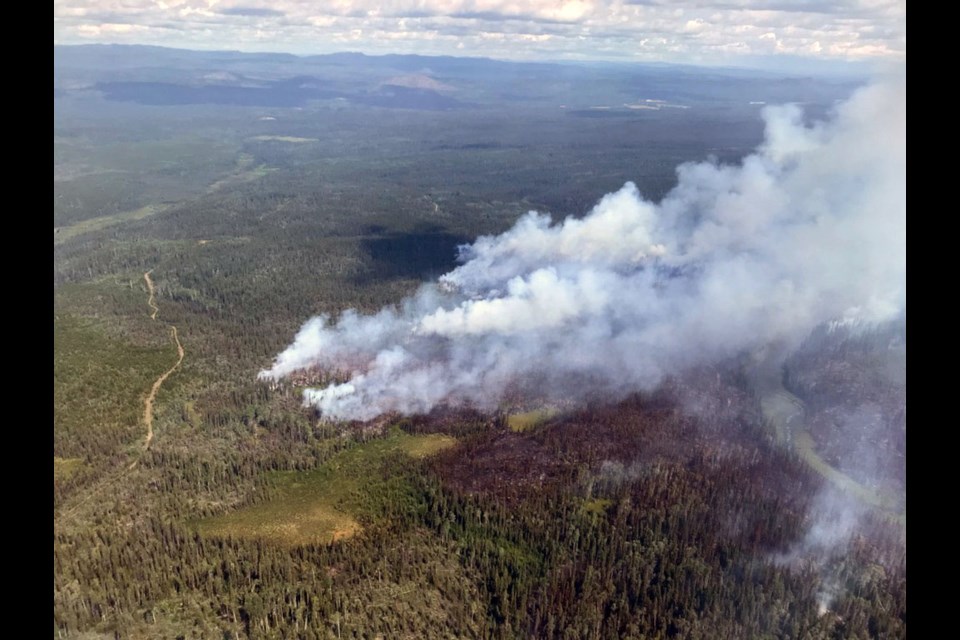Gerry Thiessen caught an unobstructed view of nature’s fiery fury last weekend when he flew in a helicopter over the Cutoff Creek fire, 45 kilometres southwest of Vanderhoof.
That lightning-caused fire grew to 23,310 hectares this week, nearly tripling in size from what it was late last week and Thiessen, the Vanderhoof mayor, could not help but think about those forests being destroyed and the longterm impact the wildfire season will have on the region.
“The information I have is the Cutoff Creek fire is still a struggle, it stuttered over the weekend around 12,000 and it appears to have doubled,” said Thiessen.
“One of the things I noticed in the helicopter ride is there’s a lot of little fires. There were fires a half a mile away from the main fire and it seemed to me (it was) really spotting a long ways away. That’s concerning because it would be very difficult for firefighters to address. With how dry the forest is, combined with the wind and the heat, that’s a deadly three that just are overwhelming. Hopefully, with a bit of precipitation and a bit more cooler weather and not so much wind, that should help.”
Smoke from the 4,600 ha Grizzly Lake fire on Thursday kept aerial crews grounded and that day they were unable to support ground-based firefighters attacking smaller fires at Punshaw Lake and Shesta Lake, about 38 kilometres southwest of Prince George, prompting an evacuation alert from the Regional District of Fraser Fort George. The Grizzly Lake fire spread rapidly, consuming trees left dead from beetle infestations over the past two decades and has crossed the boundaries of three regional districts.
Late Thursday afternoon, the Cariboo Regional District issued an evacuation alert for a 66,711 area in the Titetown/Nazko North Area that spills across the border into the Regional District of Fraser-Fort-George jurisdiction in the Nazko First Nation territory south of Cluculz Lake.
The Regional District of Bulkley-Nechako, Saik'uz First Nation and BC Parks issued an evacuation order for the Grizzly Lake fire area Wednesday evening. It encompasses an area south of the intersection of Kenney Dam Road and Brophy Road, southwest to Knewstubb Lake, and southeast to the 600 FSR, including Saik'uz IR Tatuk Lake 7, Tatuk, and Finger FSR. It does not include Kenney Dam Road where it runs adjacent to the Nechako River. An expanded order that came later Wednesday covers the area west of the Nechako River, including the Kenney Dam Road West to the Corkscrew RSF and Sinkut Road.
“The Grizzly Lake fire was about 480 hectares two days ago and (Thursday) it went to about 2,800 hectares and today the report have is it’s about 4,600 hectares and it is a big concern,” said Thiessen.
“The biggest thing is there’s so much dead wood in the forests and somehow we’ve got to get that harvested or cleaned up or broadcast-burned so there isn’t so much dead wood laying in the forests. Anywhere where they weren’t able to go in and harvest the wood, those are just explosive right now. They’re burning hot and fast.”
Both the Cuttoff Creek and Grizzly Lake fires are moving eastward. The Prince George Fire Centre (northeastern quarter of the province) is currently monitoring 67 wildfires, eight of which are threatening enough to be considered fires of note.
While some helicopters are actively dumping buckets of water to cool areas where attack crews and heavy equipment are located, there are no fixed-wing water bombers being used to fight any of the fires in the Prince George Fire District. All are currently being used to battle blazes in the southern half of the province. Thiessen said with so much industrial activity connected to the pipeline projects in northern B.C. there’s also a shortage of first-aid attendants, which limits the number of crews that can be placed along the fire lines.
“I think the province is overwhelmed right now with the amount of requests for firefighters, water bombers and helicopter bucket things,” said Thiessen. “A month ago people were calling it Juneary, talking about just how cold it was, and we had received quite a bit of rain and moisture and now, all of sudden, we got all this really dry weather. But in that earlier time, what we saw was the fires were starting down south.
“When the fires started going province-wide (B.C. Wildfire Service) management decided that life and infrastructure would be the two main things that they focused on. The fires that we have right now, they’re not going to cause a big problem right now, but the fibre supply for sawmills is really going to be affected, come a year or two years down the road when we need that timber.”
Two large fires continue to burn in sparsely-populated areas northwest of Mackenzie, including the Mount Porter fire near Omineca Provincial Park, about 140 km northwest of Mackenzie near Germandsen Landing, which prompted an evacuation order Wednesday night southeast of Manson Creek.
In the Burns Lake vicinity, about 20 south of Ootsa Lake, the lightning-caused Chief Louis Lake fire first reported July 7 has grown to 18,338 ha, burning the traditional territory of the Cheslatta Carrier First Nation. Extreme fire behaviour eased slightly with the cooler, wetter weather Friday but there were only trace amounts of precipitation in the area and it remains out of control.
The BC Wildfire Service continues to monitor 10 smaller fires along the Highway 16 corridor between Prince George and McBride, including a five ha blaze at Driscoll Creek within the boundary of The Ancient Forest/Chun T’oh Whudujut Provincial Park, and the seven ha Kido fire. Nickel said higher-priority attention will be given to fires closer to Highway 16 or those which threaten infrastructure. The Driscoll Creek fire is within the park boundary but is burning along a rock face in an area which is inaccessible to ground crews.
“Waking up and seeing that rain this morning was nice to see and the accumulation of precipitation does help with that ground-level moisture in the areas not currently impacted by fire,” said Sharon Nickel, communications specialist for the Prince George Fire Centre. “It also brings those temperatures down, so compared to last week, when we were in that heat wave, the risk of heat exhaustion for our firefighters on that fire line has gone down as well.
“The big ones we’re looking at, obviously there’s a lot of heat coming off those fires and by the time the rain is down low enough it evaporates. For the smaller spot fires, like the cluster down around Torpy southeast of the city towards The Ancient Forest, a lot of those fires are 0.01 of a hectare and the rain definitely helps,” said Nickel. “It lets us be able to take come of the monitoring and suppression efforts and move those on to ones that are perhaps bigger and more urgent of we’ve nature’s assistance on smaller fires.”
There was just a trace of rain, less than one millimetre, that fell over the region Friday morning. The only significant rainfall over the past four weeks in Prince George came in the early hours of July 10, when an intense thunderstorm brought 9.4 mm of rain. However, the forecast for tonight and Saturday is promising.
“For (Friday and Saturday) the ingredients ae there for heavy downpours in the Prince George region, up to 20 millimetres,” said Lisa Erven, a Climate Change and Environment Canada meteorologist.
The average daily high for July in Prince George is about 22 C. With a cooler weather pattern moving in, it should remain close to normal for the next week or so, with the likelihood of scattered showers or thundershowers and more seasonal temperatures expected for the rest of the month. In June, the city received only 38 per cent of the month’s typical rainfall. Usually, we get 65.3 mm and just 25 mm fell and most of that came in the first two weeks of June.
“For much of the Interior of B.C., it was a dry month and of course that heatwave really impacted all corners of the province as well, said Erven. “The highest temperature at the (Prince George) airport hit 38.4 C on June 28 and Prince George-Massey (Drive) topped out at 40.1 C on June 28. We were breaking hundreds of daily temperature records across the province for about three days during that stretch.”
Prince George was under a smoke advisory on Thursday and the air over the city was thick with visible smoke for much of the day, but a shift in wind direction brought a more southeasterly flow and the light rain Friday morning helped clear smoke particles from the air.
The province has had 139 new wildfires this week, with 2,700 personnel engaged in wildfire response, including close to 900 contractors, with 151 aircraft involved. B.C. has 119 out-of-province firefighters, with a request for another 103 from out of the country.
A crew of 20 firefighters from Quebec arrived in B.C. on Friday, while 17 firefighters from Alberta were deployed Wednesday in the Prince George Fire Centre. One crew of four firefighters was sent to the Tumbler Ridge zone, one crew of four went to the Mackenzie zone and two crews of our are not fighting fires in the Vanderhoof-Fort St. James zone. Mexico will send 100 firefighters to the province, due to arrive In Abbotsford on July 24 along with a COVID-19 safety officer. The Canadian Armed Forces and Coast Guard are now providing support with their aircraft.
Nickle strongly recommends residents of areas that could be in the path of the fires develop an evacuation plan and prepare emergency kits that contain valuable household documents and other valuables to take in case of an evacuation order on short notice. More tips on what to are on the provincial government website www.preparedbc.ca.




